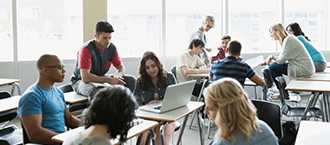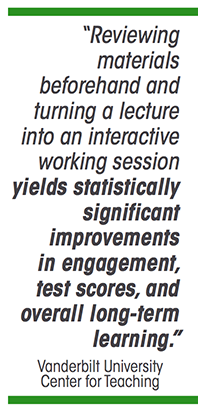- Academic Technology
What Is a Flipped Classroom?

The COVID-19 pandemic saw a massive shift in the education landscape, with a number of innovative teaching methods introduced to accommodate at-home learning — many of which stuck around as students returned to the physical classroom. The idea of the “flipped classroom” was a trend with staying power because of the way in which it enhances students’ learning experience. Student-led active learning, peer-to-peer collaboration, and individualized guidance enable educators to adapt each lesson to the individual needs of their students while encouraging connection and critical thinking. Using flipped videos to explain core concepts and introduce complicated topics also frees up valuable in-person class time for more interactive discussion between teachers and students.
 But what is a flipped classroom, exactly?
But what is a flipped classroom, exactly?
The flipped classroom inverts the traditional learning experience. Lectures are shared outside of class time for individual review as homework, and classroom time is reserved for class discussion and interactive projects. The principal goals of flipping are as follows:
- To make the classroom an active learning environment
- To enable students to learn at their own pace, and
- To give the instructor more time to teach each student individually, rather than the class as a whole.
By shifting passive lecture material to an at-home setting, students can review those materials in the time and place that works best for their needs. They can also access all the foundational information in advance, so when they enter the classroom, they feel prepared and ready to participate in interactive learning activities.
During class, teacher-guided discussions and activities require students to put the lecture materials into practice. Classroom time may be used for group work, comprehension tests, in-depth application of the subject matter, or open time for individual assignments—all with the added benefit of having a teacher and fellow students nearby for problem-solving and collaboration.
Because a flipped classroom typically involves a blend of online and face-to-face learning, the pandemic sparked a deeper interest in this approach. A combination of synchronous and asynchronous learning can fit into the model of a flipped classroom, whether it takes place completely within a virtual classroom, a hybrid model, or a pure in-person learning environment.
The Future of the Flipped Classroom
The pandemic caused a surge in the use of the flipped classroom model, as educators and students could no longer rely solely on meeting in person. This shift revealed the power of accessible, flexible, and engaging virtual learning methods, as well as the benefits that come from a blend of synchronous and asynchronous learning.
Flipped classrooms are here to stay. Their efficacy during the pandemic proved that this pedagogical approach can transcend time and location, offering unparalleled flexibility for all involved. Many educators are continuing to incorporate elements of the flipped classroom, even after returning to 100% in-person learning. They’re using video and multimedia materials outside of class time in order to make in-class time a richer, more interactive learning experience.
Why Flip? 5 Benefits That Go Beyond the Hype
Instructors have flipped their classrooms on the basis of a handful of key benefits:
1. Flipping allows students to learn at their own pace
Under the traditional lecture model, instructors must teach their curriculum within the allotted classroom time, based on the rate at which the “average” student can absorb the material. Students listen and take notes, passively receiving the lecture information. If a student has trouble with a concept, they have to either interrupt and ask a question, or do their best to keep up and request an explanation outside of class time.
By contrast, students in flipped classrooms can review any part of a recorded lecture or take breaks as needed. This type of self-paced learning is especially important for students with special needs or different learning styles. It empowers all students to take control of their learning and can even reduce anxiety. If they’re unsure about a concept, students can come to class prepared with specific questions and have ample class time to discuss them.
2. Flipped learning is customized, active, and engaging
When students cover foundational material before class, instructors in the flipped classroom can devote class time to engaging students through active learning. Group problem-solving, student presentations, and whole-group discussions allow students to learn through experience, test their comprehension, apply their knowledge, and absorb the content.
Instructors are also able to craft in-class activities that are customized to their students. Armed with data from video analytics , they can ensure that students have engaged with the pre-class content. Online quizzes also help instructors gauge each student’s level of comprehension and guide the classroom experience based on that information.
3. Flipped lecture videos help students review for exams and master the content
For more than a decade, universities have been recording traditional classroom-based lectures. Based on the experience of schools that use lecture capture technology, students often go back to recorded lectures as a study aid during midterm and final exam periods.
Flipped classroom videos can offer the same benefit as recorded in-class lectures. When pre-class materials are made available, students can go back and review those resources to better prepare for tests and exams. The ability to search for words or phrases in the recordings or play the recordings at variable speeds also helps students quickly pinpoint particular sections of the video.
4. Flipped content can be richer through curation and continuous improvement
While teachers have always curated additional resources in order to complement their own lectures, flipped learning makes that process even more effective and accessible. Because students are consuming lesson material outside of class, teachers can assign films, games, and readings, using short videos they record to tie it all together. Digital tools also expand the options for what instructors can incorporate into these lesson plans.
And as time goes on, flipped instruction benefits teachers by making better use of their own time and resources. By flipping, teachers can:
-
- Create basic lecture content once and share it with multiple classes for subsequent years
- Continually improve specific parts of lecture content by reviewing analytics, video comments and discussions in class
- Invest time in sharing new and more detailed content, either as future lessons or in classroom discussions
- Provide reliable and consistent learning materials for substitutes to use
- Collaborate with other instructors and share particularly successful videos with colleagues teaching the same subject
5. Students in flipped classrooms may show better learning outcomes
With more opportunities for interaction with the teacher, collaboration with other students, problem-solving practice, and self-paced learning, research shows students in flipped classrooms may have better short-term learning outcomes. The key is implementing flipped classroom strategies well and in a way that appeals to student sensibilities.
In some cases, educators may have to take a “softer” approach by including a limited amount of lecture time in the classroom. Or, they may need to explain the benefits of a flipped classroom to their students and give them guidance on how to learn and study. At the university level, students who have already completed introductory courses and are working toward a specific major are often more motivated to complete work outside of class time and better understand the value of interactive in-class activities than first-year students.
To see successful outcomes, teachers also need to be mindful of factors such as access to technology, nontraditional students’ outside responsibilities, the physical classroom set-up, and group assignments that allow all students to feel comfortable.
Free from the constraints of the classroom-based lecture, a flipped classroom allows students to engage in self-paced learning, as well as think critically and collaborate with classmates, all with their instructors close at hand. By combining the engagement of active learning in the classroom with the flexibility of a virtual classroom, the flipped classroom holds benefits for students and instructors alike.
Interested in joining teachers from around the world in modernizing the 21st century classroom? We’ve written a comprehensive guide to preparing, delivering, and evaluating your flipped classroom—from ideas for interactive classroom activities to the tech needed to produce recorded lessons. Download your free copy today.


